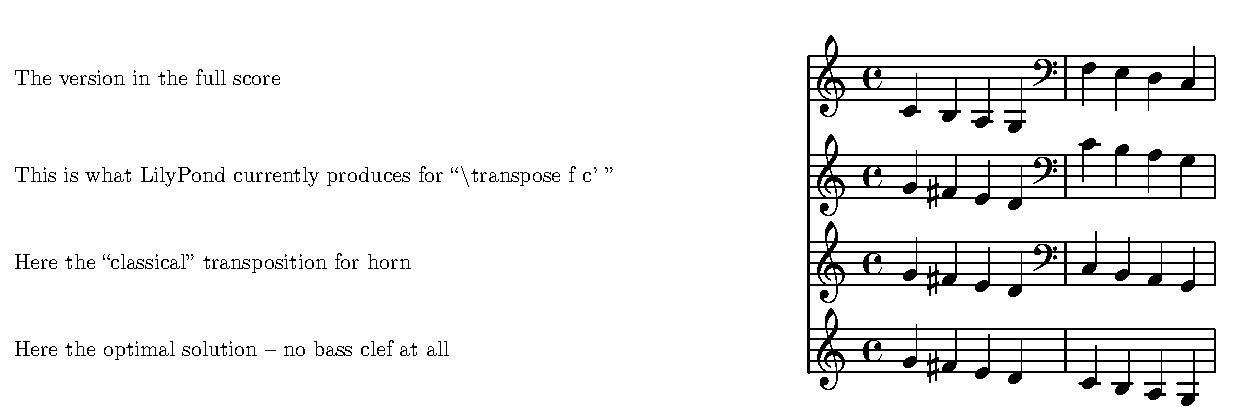[Top][All Lists]
[Date Prev][Date Next][Thread Prev][Thread Next][Date Index][Thread Index]
Re: wrong transposition of horn
|
From: |
Werner LEMBERG |
|
Subject: |
Re: wrong transposition of horn |
|
Date: |
Sat, 25 Sep 2004 16:57:30 +0200 (CEST) |
> Then why couldn't you then add something like
> \oldStyleHornBassClef = {
> \once \override OctavateEight #'transparent = ##t
> \clef "F^8" }
> ?
Lilypond shall handle this automatically. Additionally, the clef
changes in a horn part are normally different from the clef changes in
the full score. See the attached image.
> I don't really understand the difference between clef F^8 and what
> you are asking for.. to me the "old" \clef F syntax just looks like
> sloppy notation for F^8; in the same manner as \clef G often is used
> in place of \clef G_8 in many mandola and guitar scores.
But in guitar scores you always use treble clef, right? Here another
example: Take the pocket score of `Ein deutsches Requiem' (Brahms,
Edition Eulenburg) and look at page 2, bar 12/13: The horn part in F
is notated as
\notated = \relative c' { \clef treble g1 | \clef bass c,,1 }
but it sounds like this:
\sounding = \relative c { \clef bass c1 | f,1 }
What I want is that a new property is added:
\set Voice.transposeClefs = #'(treble . 0 % as-is, default
bass . -7) % octave down
\transpose f c' \sounding
This should then yield the same result as \notated.
BTW, I withdraw my second request for another property to control the
split point between automatically switching treble and bass clef. The
idea is not bad but I think it is impossible to implement in a
sensible way.
Werner

- Re: wrong transposition of horn, D Josiah Boothby, 2004/09/25
- Re: wrong transposition of horn, Werner LEMBERG, 2004/09/25
- Re: wrong transposition of horn, Han-Wen Nienhuys, 2004/09/25
- Re: wrong transposition of horn, Werner LEMBERG, 2004/09/25
- Re: wrong transposition of horn, Erik Sandberg, 2004/09/25
- Re: wrong transposition of horn,
Werner LEMBERG <=
- Re: wrong transposition of horn, D Josiah Boothby, 2004/09/25
- Re: wrong transposition of horn, Werner LEMBERG, 2004/09/25
- Re: wrong transposition of horn, Han-Wen Nienhuys, 2004/09/25
- Re: wrong transposition of horn, Werner LEMBERG, 2004/09/26
- Re: wrong transposition of horn, Josiah Boothby, 2004/09/26
- Re: wrong transposition of horn, Han-Wen Nienhuys, 2004/09/26
- Re: wrong transposition of horn, Han-Wen Nienhuys, 2004/09/26
- Re: wrong transposition of horn, Erik Sandberg, 2004/09/26
- Re: wrong transposition of horn, Werner LEMBERG, 2004/09/26
